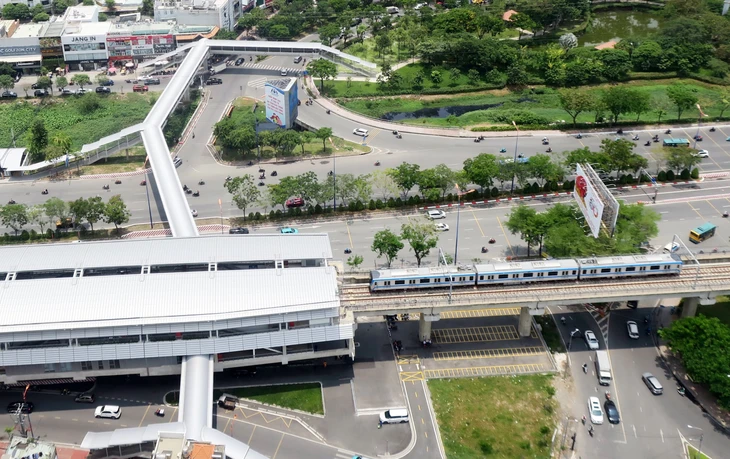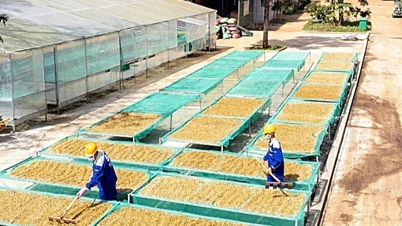
ICOR should be made public in all sectors, provinces and cities. In the photo: Metro line No. 1 Ben Thanh - Suoi Tien is one of the city's public investment projects - Photo: TTD
Reported on some new and important issues in the draft documents submitted to the 14th Party Congress recently set the goal of maintaining the ICOR index at around 4.5 - meaning that 4.5 dong of investment capital is needed to create 1 dong of additional GDP.
Speaking with Tuoi Tre, Prof. Dr. Mac Quoc Anh , Director of the Institute of Economics and Enterprise Development, shared more about the nature of ICOR and solutions to improve this index for fast and sustainable growth.
The "forgotten" measure?
* Sir, the ICOR (Incremental Capital-Output Ratio) index is considered a "measure of capital efficiency", but has long been rarely mentioned in development reports?
- The ICOR index reflects the efficiency of investment capital - that is, how much capital is needed to create an additional GDP. This is the core index that helps policymakers assess the quality of growth, not just the growth rate. However, for many years in local growth reports, ICOR has been almost "forgotten", mainly due to three reasons.
Firstly, development thinking still focuses more on quantity than quality. Many localities still use "total registered investment capital", "project scale", "total disbursed budget" as measures of success, while the efficiency of capital use is not closely monitored.
Second, there is a lack of a unified mechanism for measuring and publishing ICOR periodically. Currently, this index is mainly calculated by the General Statistics Office at the national level, while there is little complete data at the local or sectoral levels, so ICOR has not become a mandatory monitoring tool in the public and private investment process.
Third, the investment system is fragmented and lacks transparency. Without project management standards and digital technology in capital efficiency monitoring, accurate ICOR measurement is almost impossible.
As a result, in the period 2016-2020, Vietnam had an average ICOR of about 6.1, higher than many ASEAN countries (Thailand about 4, Malaysia about 3.5). This means that we are having to spend more capital to achieve the same unit of growth - a sign that investment efficiency is not commensurate with the resources spent.
* The draft documents submitted to the 14th Party Congress set a target of maintaining an ICOR of around 4.5. In your opinion, is this level feasible?
- Completely feasible, but requires a drastic change in thinking and investment methods.
To achieve this level, we need three prerequisites. One is to increase labor productivity and investment quality. Currently, Vietnam's labor productivity is only about 60% of Thailand's and 45% of Malaysia's according to ADB data in 2024. When productivity is low, ICOR will always be high, because the same amount of capital must "bear" more costs to create products.
Second is to reduce scattered investment, especially in public investment. Third is to promote digitalization of investment processes and apply project management technology, from the investment preparation stage to disbursement monitoring. When there is standardized and transparent data, capital use efficiency can be accurately measured.
Publicize ICOR index to increase monitoring
* According to you, is it necessary to publicize the ICOR index of each industry and each locality?
- This should be done as a step forward in reforming budget transparency and public investment efficiency. I believe that publishing ICOR by sector or locality has three clear positive impacts.
The first is to create pressure for transparency and healthy competition among localities. When ICOR is made public, localities that maintain low investment efficiency and generate more GDP from the same amount of capital will be recognized and attract more investment.
Second, it helps investors and private businesses have more data to make decisions, avoiding investing in inefficient areas or areas with high capital costs.
Third, support central agencies to monitor the quality of public spending and private investment more effectively, avoiding waste of resources.
Of course, to be feasible, it is necessary to standardize the way of calculating ICOR for each type of investment, avoiding unfair comparisons between the infrastructure sector (large capital, long payback period) and services or technology (small capital, fast turnover). The Ministry of Finance can preside over and coordinate with the State Audit to establish a periodic announcement system.
* To grow over 10%/year in the 2026-2030 period and achieve investment efficiency, which industries or fields should Vietnam focus capital on?
- To both grow rapidly and ensure low ICOR, Vietnam needs to reposition its investment strategy in four key areas.
The first is technology - innovation - AI and digital data. This is a group of industries with a high spillover coefficient, helping to increase productivity of the entire economy. Investing 1 dong in digital transformation can help save 3-4 dong in operating costs, according to estimates by the World Bank.
The second is green economy and renewable energy. This not only brings economic value, but also helps Vietnam comply with CBAM, ESG and Net Zero 2050 commitments, thereby expanding exports to the EU, US and Japanese markets.
Third is logistics infrastructure and growth engine areas. Developing logistics belts and corridors connecting the North, Central and South, ICDs and green supply chains helps reduce logistics costs (currently accounting for 16-18% of GDP, nearly double that of Singapore).
Fourth is vocational education and applied sciences. This is the foundation of labor productivity - a factor that directly affects ICOR. According to the International Labor Organization, Vietnam will lack more than 3 million workers with digital and green technology skills in the next 5 years.
Source: https://tuoitre.vn/can-minh-bach-chi-so-icor-20251103090155885.htm


![[Photo] Ca Mau "struggling" to cope with the highest tide of the year, forecast to exceed alert level 3](https://vphoto.vietnam.vn/thumb/1200x675/vietnam/resource/IMAGE/2025/11/04/1762235371445_ndo_br_trieu-cuong-2-6486-jpg.webp)
![[Photo] Panorama of the Patriotic Emulation Congress of Nhan Dan Newspaper for the period 2025-2030](https://vphoto.vietnam.vn/thumb/1200x675/vietnam/resource/IMAGE/2025/11/04/1762252775462_ndo_br_dhthiduayeuncbaond-6125-jpg.webp)


![[Photo] The road connecting Dong Nai with Ho Chi Minh City is still unfinished after 5 years of construction.](https://vphoto.vietnam.vn/thumb/1200x675/vietnam/resource/IMAGE/2025/11/04/1762241675985_ndo_br_dji-20251104104418-0635-d-resize-1295-jpg.webp)
![[Photo] Ho Chi Minh City Youth Take Action for a Cleaner Environment](https://vphoto.vietnam.vn/thumb/1200x675/vietnam/resource/IMAGE/2025/11/04/1762233574890_550816358-1108586934787014-6430522970717297480-n-1-jpg.webp)


































































































Comment (0)